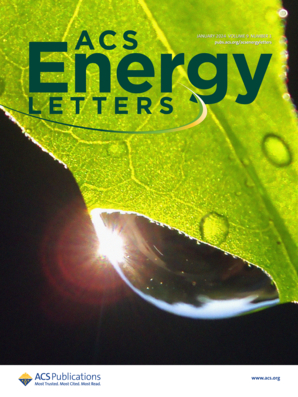减少卤化锡钙钛矿太阳能电池挥发性有机化合物损失的协同溶剂和表面工程
IF 19.3
1区 材料科学
Q1 CHEMISTRY, PHYSICAL
引用次数: 0
摘要
卤化锡钙钛矿(通常是FASnI3)在光电性能上与铅(Pb)基钙钛矿相似,但具有不同的结晶动力学,导致器件性能低下。在本研究中,我们制备了高开路电压(VOC)为1042 mV,功率转换效率(PCE)为15.48%的fasn -卤化物钙钛矿太阳能电池(PSCs),并经独立光伏实验室验证。通过采用综合溶剂和表面工程策略,我们增强了晶体稳定性和晶粒尺寸,降低了陷阱态密度,并改善了能级排列。这是通过在异丙醇(IPA)中使用N,N-二乙基甲酰胺(DEF)和四乙基溴化铵(TEABr)的预热溶液混合物对钙钛矿薄膜进行后处理,在表面和体晶界引入四乙基铵(TEA+)阳离子来实现的。这种方法还有效地抑制了Sn2+到Sn4+的氧化,从而减少了晶界处的载流子捕获。此外,该策略的有效性和可扩展性通过1.02 cm2的有源面积器件进行验证,实现了12.21%的高PCE。我们的研究结果强调了Sn-halide PSCs在效率和稳定性方面与Pb-based PSCs竞争的潜力,为更环保,无pb的替代品铺平了道路。本文章由计算机程序翻译,如有差异,请以英文原文为准。

Synergistic Solvent and Surface Engineering to Reduce VOC Loss in Tin Halide Perovskite Solar Cells
Tin (Sn) halide perovskites, typically FASnI3, resemble their lead (Pb)-based counterparts in optoelectronic properties but possess dissimilar crystallization kinetics leading to meager device performance. In this study, we fabricated FASn-halide perovskite solar cells (PSCs) with a high open-circuit voltage (VOC) of 1042 mV and a power conversion efficiency (PCE) of 15.48%, as verified by an independent photovoltaic lab. By employing a comprehensive solvent and surface engineering strategy, we enhanced crystal stability and grain size, reduced trap state density, and improved energy level alignment. This was achieved by introducing tetraethylammonium (TEA+) cation at both surface and bulk grain boundaries, through the post-treatment of perovskite film with a preheated solution mixture of N,N-diethylformamide (DEF) and tetraethylammonium bromide (TEABr) in isopropanol (IPA). This approach also effectively suppressed the notorious Sn2+ to Sn4+ oxidation, resulting in reduced charge carrier trapping at grain boundaries. Moreover, the effectiveness and scalability of this strategy are validated with a 1.02 cm2 active area device, achieving a high PCE of 12.21%. Our findings highlight the potential of Sn-halide PSCs to rival Pb-based PSCs in efficiency and stability, paving the way for more environmentally friendly, Pb-free alternatives.
求助全文
通过发布文献求助,成功后即可免费获取论文全文。
去求助
来源期刊

ACS Energy Letters
Energy-Renewable Energy, Sustainability and the Environment
CiteScore
31.20
自引率
5.00%
发文量
469
审稿时长
1 months
期刊介绍:
ACS Energy Letters is a monthly journal that publishes papers reporting new scientific advances in energy research. The journal focuses on topics that are of interest to scientists working in the fundamental and applied sciences. Rapid publication is a central criterion for acceptance, and the journal is known for its quick publication times, with an average of 4-6 weeks from submission to web publication in As Soon As Publishable format.
ACS Energy Letters is ranked as the number one journal in the Web of Science Electrochemistry category. It also ranks within the top 10 journals for Physical Chemistry, Energy & Fuels, and Nanoscience & Nanotechnology.
The journal offers several types of articles, including Letters, Energy Express, Perspectives, Reviews, Editorials, Viewpoints and Energy Focus. Additionally, authors have the option to submit videos that summarize or support the information presented in a Perspective or Review article, which can be highlighted on the journal's website. ACS Energy Letters is abstracted and indexed in Chemical Abstracts Service/SciFinder, EBSCO-summon, PubMed, Web of Science, Scopus and Portico.
 求助内容:
求助内容: 应助结果提醒方式:
应助结果提醒方式:


